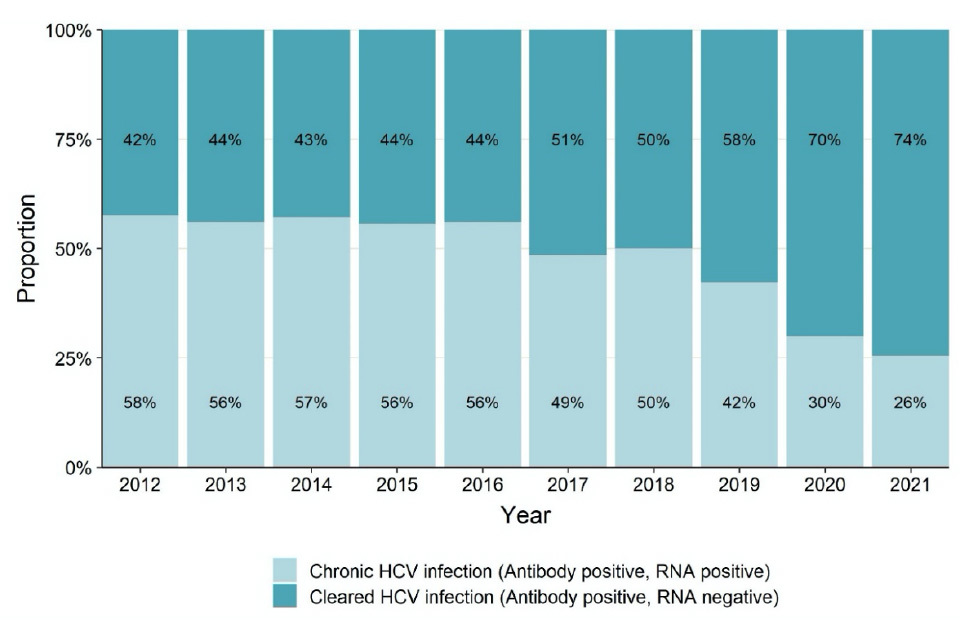HPR volume 16 issue 8: news (18 August 2022)
Updated 30 December 2022
HIV and viral hepatitis in people who inject drugs: annual report in summary
The UK Health Security Agency (UKHSA) has published new data from the Unlinked anonymous monitoring (UAM) survey of people who inject drugs (PWID) covering England, Wales and Northern Ireland for the period 2012 to 2021. This news report summarises the main findings.
The UAM survey is an annual, cross-sectional bio-behavioural survey recruiting PWID through drug and alcohol services across England, Wales, and Northern Ireland. Prevalence data is available for HIV, hepatitis C virus (HCV) (antibodies and RNA) and hepatitis B virus (HBV) (antibodies to HBV core antigen and HBV surface antigen), alongside self-reported data for risk and protective behaviours.
Overall, chronic hepatitis C (hepatitis C RNA and antibody positive) prevalence continues to decline and was 26% in 2021 (Figure 1). The relative decline in chronic infection corresponds with the scale-up of direct acting antiviral treatment for hepatitis C among PWID and likely reflects the impact of treatment and viral clearance in this group, as well as increased recent uptake of diagnostic testing in some nations. However, decreases in hepatitis C chronic prevalence are not equitable across all nations and regions of England. Among recent initiates to injecting (those who began injecting drugs up to 3 years prior to survey participation) there was no change in chronic hepatitis C prevalence over the past decade, suggesting ongoing new infections in this group and a need for renewed investment and focus on harm reduction.
Figure 1. Prevalence of chronic HCV (RNA-positive) among anti-HCV-positive participants in the UAM Survey of PWID: England, Wales, and Northern Ireland, 2012 to 2021

A focus on harm reduction is especially important given the observed increase in injecting risk behaviours in this group in 2021, with increases in the proportion reporting stimulant injection and injecting equipment sharing in the past month. Although in 2021 the prevalence of antibodies to hepatitis B core antigen (a marker of ever HBV infection) continued to decline, hepatitis B vaccine uptake was at the lowest level seen in the past decade (61%), with uptake even lower among recent initiates to injecting and those aged under 25 years.
In 2021, over one quarter of those who had injected drugs in the past year reported experiencing a non-fatal overdose during that year, the highest levels seen since 2013 when this question was first asked.
Coronavirus (COVID-19) has continued to impact services aimed at PWID during 2021, with many participants reporting difficulties in accessing essential services such as needle and syringe programmes (NSP), drug treatment, naloxone and blood-borne virus testing.
Further outputs from the UAM survey include data for hepatitis C antibody, HIV prevalence and data for risk and protective behaviours, such as diagnostic testing uptake and naloxone use and carriage, as well as a section detailing the impact of the COVID-19 pandemic on this population.
The latest data release comprises 2 publications:
-
a set of data tables titled: ‘People who inject drugs: HIV and viral hepatitis monitoring unlinked anonymous monitoring survey tables (psychoactive): 2022 report’
-
a short accompanying report titled: ‘Unlinked Anonymous Monitoring (UAM) Survey of HIV and viral hepatitis among PWID: 2022 report’
Both the above publications are available on the webpage People who inject drugs: HIV and viral hepatitis monitoring.
Infection reports
Common animal-associated infections (England and Wales): second quarter 2022.
